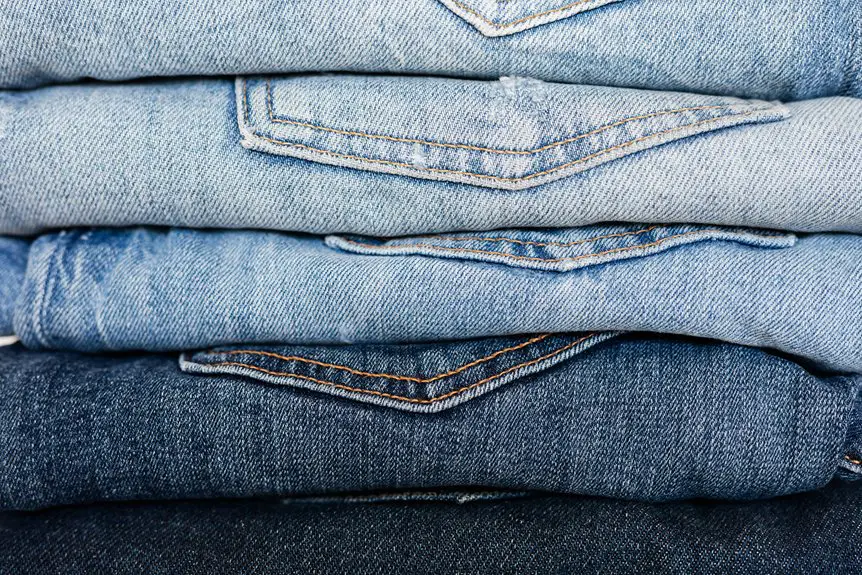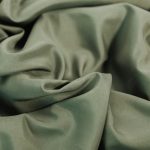If you want a gown with a relaxed, natural look that’s durable and easy to care for, choose crepe. Its matte, slightly textured surface drapes softly and resists wrinkles, perfect for daytime or semi-formal events. For a sleek, glamorous vibe with bold silhouettes, satin’s smooth, glossy finish is ideal, though it requires extra care. Depending on your event and style, one fabric will suit you better—explore further to find the perfect match for your gown.
Table of Contents
Key Takeaways
- Crepe offers a matte, textured look with a relaxed feel, while satin provides a smooth, glossy, and luxurious appearance.
- Crepe drapes softly and highlights natural curves; satin creates structured, dramatic silhouettes ideal for formal gowns.
- Crepe is durable, wrinkle-resistant, and low-maintenance, whereas satin requires careful handling and typically dry cleaning.
- Crepe suits daytime and semi-formal events; satin is perfect for evening occasions, weddings, and glamorous settings.
- Pair crepe gowns with minimalist jewelry and matte shoes; choose bold accessories and sleek updos to complement satin dresses.
Understanding the Texture and Feel of Crepe and Satin
Texture plays an essential role when choosing between crepe and satin for your gown.
Crepe has a slightly rough, grainy surface that feels light and flexible. When you touch it, you notice its matte finish and subtle pebbled texture, which adds depth without shine.
Crepe features a light, flexible feel with a matte, subtly textured surface that adds depth without shine.
Satin, on the other hand, feels smooth, silky, and luxurious against your skin. Its glossy surface catches the light, giving your gown an elegant, luminous look. You’ll find satin heavier and more structured compared to crepe’s airy softness.
Both fabrics feel distinct—crepe offers a relaxed, natural vibe, while satin delivers a polished, glamorous touch. Understanding these differences helps you pick a fabric that matches not only your style but also your comfort preferences for the occasion.
How Crepe and Satin Drapes Affect Gown Silhouettes
Beyond how they feel to the touch, the way crepe and satin drape can completely change your gown’s silhouette.
Crepe offers a matte finish with a slightly textured surface, allowing it to drape fluidly and cling softly to your curves. If you want a gown that moves gracefully and highlights your natural shape without extra volume, crepe is your go-to.
Satin, on the other hand, has a glossy, smooth surface that gives your gown structure and sheen. It tends to hold shape more firmly, creating dramatic, voluminous silhouettes like ball gowns or structured A-lines. Choosing satin means your gown will have more body and a polished look.
Consider how you want your dress to flow and frame your figure—crepe for gentle elegance, satin for bold, sculpted style.
Comparing the Durability and Maintenance of Crepe and Satin
While choosing between crepe and satin, you’ll also want to contemplate how each fabric holds up over time and what care they require.
Crepe is known for its durability; it resists wrinkles and maintains texture even after multiple wears. You can usually machine wash crepe gently, making upkeep simpler.
Satin, on the other hand, is more delicate. Its smooth, glossy surface is prone to snags and stains, so you’ll likely need to dry clean it to keep it looking pristine. Satin wrinkles easily, requiring careful ironing or steaming.
If you want a gown that’s low-maintenance and tough enough for repeated use, crepe might be your best bet. But if you’re prepared to handle extra care for that luxurious shine, satin could still be worth it.
Ideal Occasions for Wearing Crepe vs. Satin Gowns
When should you choose crepe over satin for your gown?
Opt for crepe when you want a fabric that feels lightweight and breathable, perfect for daytime events or outdoor celebrations. Its matte finish suits casual to semi-formal occasions, like garden parties or business functions, where understated elegance is key.
Choose crepe for lightweight breathability and a matte finish, ideal for daytime and semi-formal events with understated elegance.
On the other hand, satin’s smooth, glossy surface makes it ideal for evening events, galas, or weddings, where you want to make a bold, luxurious statement. Satin gowns catch the light beautifully, adding drama and sophistication.
If you’re attending something formal or festive, satin elevates your look instantly. By considering the event type and atmosphere, you can pick the fabric that complements both your style and the occasion perfectly.
Styling Tips to Complement Crepe and Satin Fabrics
Although crepe and satin each bring unique textures to your gown, you can enhance their appeal by choosing complementary accessories and styling techniques.
For crepe, which offers a matte, slightly textured finish, opt for minimalist jewelry to keep the look elegant yet understated. Satin’s glossy sheen pairs beautifully with bold accessories that add sparkle and drama.
When styling your hair, soft waves work well with crepe’s subtle texture, while sleek updos highlight satin’s smooth surface. Consider these tips to elevate your gown:
- Pair crepe with delicate pearl earrings and a simple clutch for a refined touch.
- Add statement necklaces or sparkling hairpins to satin for evening glam.
- Choose shoes with matte finishes for crepe and shiny, patent styles for satin gowns.
Frequently Asked Questions
Are Crepe and Satin Fabrics Environmentally Friendly?
You should know both crepe and satin can impact the environment differently. Crepe varies by fiber, while satin often involves synthetic fibers. You’ll want to check for sustainable sources or eco-friendly certifications to make a greener choice.
Can Crepe and Satin Be Mixed in One Gown Design?
You know what they say, “Variety is the spice of life.” You can definitely mix crepe and satin in one gown design, as long as you balance textures and colors to create a harmonious, elegant look that highlights both fabrics.
Do Crepe and Satin Fabrics Cause Allergies?
You usually won’t have allergic reactions to crepe or satin since they’re made from natural or synthetic fibers. However, if you have sensitive skin, test a small patch first to avoid irritation or allergies.
Which Fabric Is Better for Hot Climates, Crepe or Satin?
Did you know 70% of people feel more comfortable in breathable fabrics during summer? You’ll find crepe better for hot climates since it’s lightweight and breathable, while satin tends to trap heat and feel less airy.
How Do Crepe and Satin Gowns Perform in Professional Photos?
You’ll find satin gowns reflect light beautifully, adding elegance to photos, while crepe offers a matte finish that reduces glare and hides wrinkles better. Choose based on the vibe and lighting of your shoot.
- Does Chiffon Fabric Stink - July 15, 2025
- Does Chiffon Fabric Affect the Economy - July 15, 2025
- Does Cotton Fabric Have a Nap - July 15, 2025







